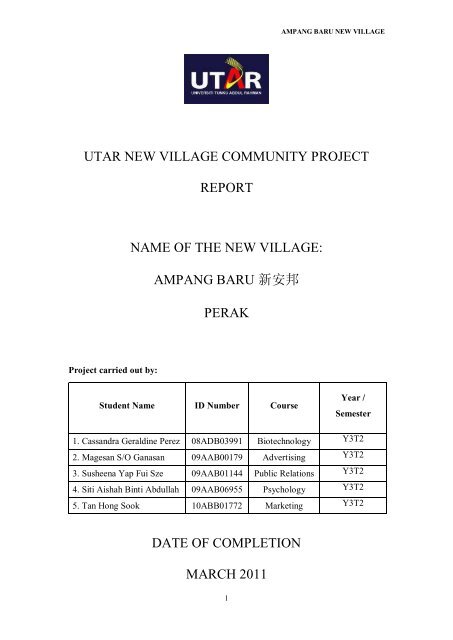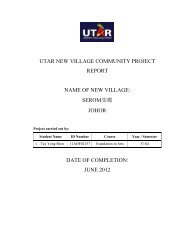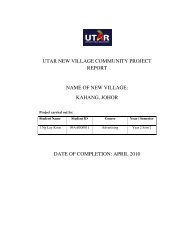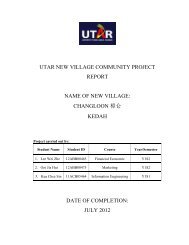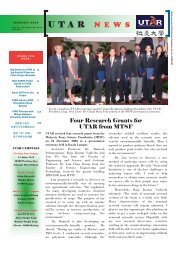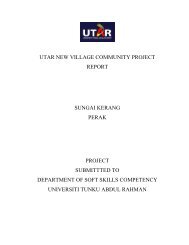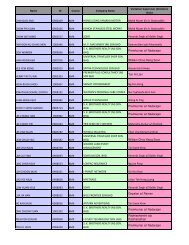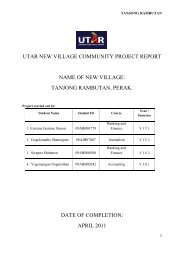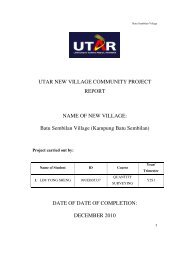A NEW VILLAGE PROJECT AT aMPANG bARU, iPOH
A NEW VILLAGE PROJECT AT aMPANG bARU, iPOH
A NEW VILLAGE PROJECT AT aMPANG bARU, iPOH
You also want an ePaper? Increase the reach of your titles
YUMPU automatically turns print PDFs into web optimized ePapers that Google loves.
AMPANG BARU <strong>NEW</strong> <strong>VILLAGE</strong>Name: Tan Hong SookThis project has helped me to learn a lot about thecurrent situation of new villages these days inMalaysia. I had fun doing this project with myfriends. Most of all, I would like to say thank you tothose who helped us to make this project successful.5
AMPANG BARU <strong>NEW</strong> <strong>VILLAGE</strong>Figure 10: Housing in Ampang Baru that still retains the old „kampung‟ house structureFigure 11: Housing in Ampang Baru – an extended old „kampung‟ house12
AMPANG BARU <strong>NEW</strong> <strong>VILLAGE</strong>Figure 12: A house in Ampang Baru which has been renovated in a style commonIn the cities.13
AMPANG BARU <strong>NEW</strong> <strong>VILLAGE</strong>DEMOGRAPHIC INFORM<strong>AT</strong>IONIn this „kampung”, there are approximately 515 houses and 2,000 to 2,500residents. Unfortunately the population has been decreasing for over the past 10 yearsor so. The vast majority of the population is Chinese, while there are also a fewMalays. Buddhism and Taoism are the dominant religious. Ampang Baru has its owntemple and mosque. The village has only one local voluntary organization, the DeathBenefit Society.Figure 13: Tokong Teng Wai Kin, which is located on the outskirts ofthe AmpangBaru town.- a Buddhist templeFigure 14: Masjid Sultan Azlan Shah, situated in between the old Ampangand Ampang Baru new village14
AMPANG BARU <strong>NEW</strong> <strong>VILLAGE</strong>Figure 15: The Buddhist temple Teng Wai Kin, with their very ownreligious association called the Association of SincereDevotees of BuddhismFigure 16: The local town hall called the „Dewan Orang Ramai AmpangBaru‟15
AMPANG BARU <strong>NEW</strong> <strong>VILLAGE</strong><strong>VILLAGE</strong> INFRASTRUCTUREAmpang Baru villagers have access to basic infrastructure and facilities.Piped water supply and electricity are available. The Public Works Department ofIpoh, Perak, Malaysia (Jabatan Kerja Raya Ipoh Malaysia) provides villagers withwater to carry out their daily chores, such as watering plants and washing. Thevillagers feel that their water supply for household and outdoor use is excellent.Electricity supply for this village is provided by Tenaga Nasional Berhad (TNB).In Ampang Baru, water and electricity supply are provided by the governmentagency. The source of water is from the Public Works Department of Ipoh, Perak,Malaysia (Jabatan Kerja Raya Ipoh Malaysia); villagers use this source of water tocarry out their daily chores, such as bathing, watering plant, washing and more. Fromthe villagers‟ review, their water supply for household and outdoor use is excellent.On the other hand, the Ampang Baru new village‟s electricity supply is provided byTenaga Nasional Berhad (TNB).Figure 17: Tenaga Nasional Berhad (TNB) supplies electricity to the new villageof Ampang Baru16
AMPANG BARU <strong>NEW</strong> <strong>VILLAGE</strong>Figure 18: Tenaga Nasional Berhad (TNB) supplieselectricity to the new village of Ampang BaruFigure 19: A flood station, „Stesen Siren Amaran Banjir‟, serves as a warningdevice if water on the ground reaches catastrophic levels.17
AMPANG BARU <strong>NEW</strong> <strong>VILLAGE</strong>Each household in Ampang Baru has its own sewage disposal, a flush system.Waste disposal is handled by the Municipal Council while open burning is practisedby some older residents; efforts are being made to stop this practice.In Ampang Baru, TELEKOM Malaysia offers excellent telecommunicationservices to the villagers, including internet installation in some household. AmpangBaru is equipped with facilities such as a community hall and a recreation field.There are not more than 50 shops located in Ampang Baru. These shops includerestaurants, a pharmacist, grocery shops and a wet market.Unfortunately, there is no police station located within the vicinity of the ofthe Ampang Baru new village. The nearest police station is 15 minutes‟ drive away.Besides that, medical services are also not available in this new village. The nearesthospital is Hospital Pantai Ipoh which is, a 15- minute drive from Ampang Baru.Villagers complaint about the high cost of medical services at this hospital. On top ofthat, there are no government clinics or other medical services to support this village.This is a serious issue which most of the villagers we interviewed have complainedabout. The villagers express the hope that the government would provide them withbetter access to medical care and security services.Figure 20: Chinese Medical Hall18
AMPANG BARU <strong>NEW</strong> <strong>VILLAGE</strong>Figure 21: MS Moshi Moshi Enterprise, a small training centre in Ampang Baru.Figure 22: One of the many Ampang Baru new village coffee shops which sell „mee‟soup or curry and drinks19
AMPANG BARU <strong>NEW</strong> <strong>VILLAGE</strong>Figure 23: Another local medical hallFigure 24: „Soon Fatt‟ grocery store or convenience store, which sells dry groceries andhousehold items at very affordable pricing20
AMPANG BARU <strong>NEW</strong> <strong>VILLAGE</strong>Figure 25: More Ampang Baru new village coffee shops which sell „mee‟ soup or curryand drinksFigure 26: The „Pasar Awam Ampang Baru‟, a local wet market, located right besidethe grocery store in figure 24. Fruits, vegetables and poultry are sold here21
AMPANG BARU <strong>NEW</strong> <strong>VILLAGE</strong>Figure 27: Some of the local food stalls at the wet market selling „Yong Tau Foo‟and prawn noodles22
AMPANG BARU <strong>NEW</strong> <strong>VILLAGE</strong>RELIGIOUS AND ASSOCI<strong>AT</strong>IONS IN AMPANG BARUThe religious buildings in Ampang Baru that we have discovered include:(a) Tokong Teng Wai KinFigure 28: Buddhist statues in glass cases surrounding the temple sightFigure 29: An Altar at the Buddhist temple23
AMPANG BARU <strong>NEW</strong> <strong>VILLAGE</strong>Figure 30: Another statue of Buddha in the templeFigure 31: A tree for Buddhist to place their offerings24
AMPANG BARU <strong>NEW</strong> <strong>VILLAGE</strong>Figure 32: Another statue of Buddha at the templeFigure 33: Beautiful statue of Buddha at the temple garden25
AMPANG BARU <strong>NEW</strong> <strong>VILLAGE</strong>Figure 34: Many different Buddhist statues in thetemple gardens26
AMPANG BARU <strong>NEW</strong> <strong>VILLAGE</strong>Figure 35: Taoism is the religion of most villagers in the Ampang Baru new village.The altars for worship shown in the picture are religious symbol foundoutside many homes.Figure 36: This is a statue captured from a Buddhist temple situated on the outskirts ofthe Ampang Baru new village27
AMPANG BARU <strong>NEW</strong> <strong>VILLAGE</strong>(b) MasjidFigure 37: The only local mosque in the Ampang Baru new village28
AMPANG BARU <strong>NEW</strong> <strong>VILLAGE</strong>The political party with an office in Ampang Baru is the Malaysian ChineseAssociation (MCA). There is a local organisation for the handicapped called the„Persatuan Pemulihan Orang Cacat Perak.‟Figure 38: The „Persatuan Pemulihan Orang Cacat Perak‟ is located behindSJK (C) Min SinFigure 39: The „Persatuan Pemulihan Orang Cacat Perak‟ store, where beautiful rattanhandicrafts are sold to support the society‟s activities29
AMPANG BARU <strong>NEW</strong> <strong>VILLAGE</strong>EDUC<strong>AT</strong>ION IN AMPANG BARUAmpang Baru has only one Chinese primary school and one Chinese kindergartenwhich are private and another Chinese kindergarten supported by the public. There isno secondary school in the new village. Therefore, secondary school students have totravel quite a distance to school. The only Chinese primary school is named SJK (C)Min Sin Ampang Baru and it was opened in 1953. Currently, it employs 36 teachersand has 537 students only. The headmaster of this school is Mr. Hui Leong Kan.Besides, the only private kindergarten was established in 2007 and currently has 25students and 1 teacher only.Figure 40: Sekolah Jenis Kebangsaan (Cina) Min Sin, Ampang Baru with the school‟semblem on its front wall.30
AMPANG BARU <strong>NEW</strong> <strong>VILLAGE</strong>Figure 41: Cafeteria scene in the Min Sin primary schoolFigure 42: A plaque commemorating the official opening of a new school building31
AMPANG BARU <strong>NEW</strong> <strong>VILLAGE</strong>Figure 43: The school is currently facing a shortage of classrooms as well as otherimportant school facilitiesFigure 44: A public kindergarten for preschoolers named „Kelas PrasekolahSJK (C) Min Sin, Ampang Baru32
AMPANG BARU <strong>NEW</strong> <strong>VILLAGE</strong>Figure 45: A private kindergarten for preschoolers, just down the street from theMin Sin Preschool called „Tadika Yoke Chee‟, Kampung Ampang Baru33
AMPANG BARU <strong>NEW</strong> <strong>VILLAGE</strong>ECONOMIC ACTIVITIESThe cultivation of pamelo trees is the primary economic activity in this village.Besides that, farming, especially vegetable farming, is another source of income.According to our research, most Ampang Baru households have monthly income ofRM1, 000 or higher.Figure 46: Some pineapple plants scattered around a backyard in a house with asmall vegetable garden at the far back34
AMPANG BARU <strong>NEW</strong> <strong>VILLAGE</strong>Figure 47: Most vegetables sold at the local Ampang Baru wet market is homegrownand freshly plucked and brought to the market35
AMPANG BARU <strong>NEW</strong> <strong>VILLAGE</strong>ENTREPRENEURSHIP OPPORTUNITYEntrepreneurship ranges in scale from solo projects, even involving the entrepreneuronly part-time, to major undertakings creating many job opportunities. Ampang Barunew village, has a number of small scale entrepreneurial businesses in the food sector.However, the major entrepreneurial activity in this village involves motor vehiclerepair. In fact, there are several motor vehicle repair shops along the main roadAmpang Baru. Perhaps there are opportunities to develop these businesses further.Figure 48: Many Chinese owned coffee shops in Ampang Baru have small hawkerstalls selling a variety of food.36
AMPANG BARU <strong>NEW</strong> <strong>VILLAGE</strong>Figure 49: Some hawker stalls are located at the roadside.Figure 50: The motor vehicle repair business proves to be quite a promisingentrepreneurship prospect. This picture shows only one of the manymotor vehicle repair outlets in Ampang Baru new village37
AMPANG BARU <strong>NEW</strong> <strong>VILLAGE</strong>PROBLEMSThe local police station is located in a house lot. This may not have a direct effect onthe safety of the villagers but the house lot is hardly recognizable as a police station.The local police force of the village, who work hard for the safety and security of thevillage, deserve a better work environment. The lack of a hospital or other medicalservices in Ampang Baru poses a problem to villagers. This is an especially seriousproblem in view of the aging population of the village.Figure 51: „Balai Polis Ampang Baru‟ logo and motto at the front of the building38
AMPANG BARU <strong>NEW</strong> <strong>VILLAGE</strong>Figure 52: The police station of Ampang Baru still remains a double story housing lotwhile waiting for the building up of a proper lot for an official Ampang Barupolice stationAnother problem faced by villagers is the absence of a secondary school in AmpangBaru. Besides that, the only primary school, SJK (C) Min Sin, faces a severe shortageof class rooms and teaching facilities. Moreover, the school has no assembly hall andthe afternoon schooling students have no choice but to queue under the hot sun in theschool field during school assemblies.39
AMPANG BARU <strong>NEW</strong> <strong>VILLAGE</strong>Figure 53: The SJK (C) Min Sin of Ampang Baru is still lacking in classrooms aswell as computer rooms for the studentsFigure 54: The school‟s weekly assembly held under the blazing hot sun because thereis no school hall40
AMPANG BARU <strong>NEW</strong> <strong>VILLAGE</strong>As many residents in the working age group have out migrated to seek betteremployment opportunities, the village has an aging population.Figure 55: Most of the younger generation venture out of the new village to seek highereducation and better job opportunitiesThe old folks are left behind.Figure 56: One of our team members conversing with some of the local old women folkas a source of information collection41
AMPANG BARU <strong>NEW</strong> <strong>VILLAGE</strong>Figure 57: We gathered information about the village being populated mainly by elderlypeople. This is the result of out-migration of the younger generation.During our interviews with local villagers, many expressed grave concern overmatters of land grants and rights of tenure. The lack of agricultural land, especiallyfor pamelo orchards, housing land have made the area around Ampang Baru slightlycongested. Social problems such as drug abuse, gangsterism, and unemployment arenot common in Ampang Baru.42
AMPANG BARU <strong>NEW</strong> <strong>VILLAGE</strong>RECOMMEND<strong>AT</strong>IONWe recommend that a local committee be formed to deal with local issues and theauthorities. Such a committee could pressure the government to construct a policestation in Ampang Baru. The committee could urge the authorities for better facilitiesin the village, e.g. availability of medical facilities.Figure 58: The „Pertubuhan Faedah Bersama Ampang Baru‟ known as the DeathBenefit Society, a community hall, situated behind the wet market placeIt is vital for the younger generation in the village to have easy access to schools andproper school facilities. We recommend that the Ministry looks into improvement infacilities of the existing schools, e.g. adding more classrooms and an assembly hall.In addition to that, the ministry should consider financial support for the school todevelop a conducive education environment.DISCLAIMER:Information contained in this report was compiled by the University‟s students on voluntary basis.Although every effort has been made to check the accuracy of the report, the University accepts noresponsibility whatsoever for any errors or omissions, if any, the University reserves the right to makechanges on the information at any time without prior notice.Should there be any queries regarding contents of the report, please contact:Department of Soft Skills CompetencyTel: 03-78582628 ext 8274, 8656, 8269 (Klang Valley Campus)05- 4688888 ext 2297/2299/2300 (Perak Campus)43


